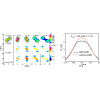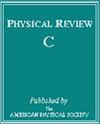严格角动量守恒的中能重离子碰撞中的自旋动力学
IF 3.1
2区 物理与天体物理
Q1 Physics and Astronomy
引用次数: 0
摘要
我们基于改进的自旋和等空间依赖的波兹曼-厄林-乌伦贝克(SIBUU)输运模型,特别是结合严格的角动量守恒约束,重新研究了中等能量重离子碰撞中的自旋动力学。我们研究了自由核子和三子/He3 的自旋极化以及氘核的自旋排列,并预测了它们不同自旋态的流动分裂。我们还证明了与自旋相关的势能可能会增强耗散,从而在低碰撞能量时对自旋平均横向流动产生不可忽略的影响。当在每个自旋相关的核子-核子碰撞中加入严格的角动量守恒时,它会影响整体动力学、流和自旋极化,而自旋轨道势对自旋相关观测值的影响仍然是可观的。完善的 SIBUU 模型可以进一步扩展到超子或矢量介子,或用作相对论重离子碰撞中自旋相关研究的强子后燃器,并在未来加入更多的非弹性通道。本文章由计算机程序翻译,如有差异,请以英文原文为准。

Spin dynamics in intermediate-energy heavy-ion collisions with rigorous angular momentum conservation
We have revisited the spin dynamics in intermediate-energy heavy-ion collisions based on the improved spin- and isospin-dependent Boltzmann-Uehling-Uhlenbeck (SIBUU) transport model, particularly with the constraint of rigorous angular momentum conservation incorporated. We have studied the spin polarization of free nucleons and as well as the spin alignment of deuterons, and predicted the flow splittings for their different spin states. We have also demonstrated that the spin-dependent potential may enhance dissipations and thus have a non-negligible effect on the spin-averaged transverse flow at low collision energies. When rigorous angular momentum conservation in each spin-dependent nucleon-nucleon collision is incorporated, it affects the overall dynamics, the flow, and also the spin polarization, while the effects of the spin-orbit potential on the spin-related observables are still appreciable. The well-developed SIBUU model could be further extended to include hyperons or vector mesons, or used as a hadronic afterburner for spin-related studies in relativistic heavy-ion collisions, with more inelastic channels incorporated in the future.
求助全文
通过发布文献求助,成功后即可免费获取论文全文。
去求助
来源期刊

Physical Review C
物理-物理:核物理
CiteScore
5.70
自引率
35.50%
发文量
0
审稿时长
1-2 weeks
期刊介绍:
Physical Review C (PRC) is a leading journal in theoretical and experimental nuclear physics, publishing more than two-thirds of the research literature in the field.
PRC covers experimental and theoretical results in all aspects of nuclear physics, including:
Nucleon-nucleon interaction, few-body systems
Nuclear structure
Nuclear reactions
Relativistic nuclear collisions
Hadronic physics and QCD
Electroweak interaction, symmetries
Nuclear astrophysics
 求助内容:
求助内容: 应助结果提醒方式:
应助结果提醒方式:


